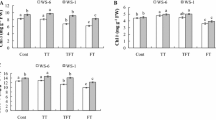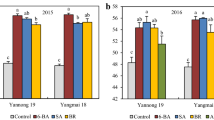Abstract
Winter rape (Brassica napus L. cv. 601) seedlings were treated with 50 mg.l-1of foliar-applied uniconazole and then exposed to heat stress with a light/dark temperature regime of 43 °C/38 °C for 3 days at the stem elongation stage. Heat stressed plants contained lower endogenous GA3, IAA and zeatin contents than the controls, while ABA content and ethylene level were increased significantly. Uniconazole-treated plants had lower endogenous GA3 and IAA contents, and higher zeatin and ABA contents and ethylene levels. Leaf chlorophyll content and respiratory capacity of roots were reduced markedly after plants were subjected to heat stress, and foliar sprays of uniconazole retarded the degradation of chlorophyll and increased respiratory capacity of roots. Following exposure to heat, the activities of superoxide dismutase and peroxidase were significantly reduced. Uniconazole-induced heat tolerance was accompanied by increased activities of various antioxidant enzymes. Foliar applications of uniconazole reduced electrolyte leakage and malondialdehyde accumulation caused by heat stress, suggesting that uniconazole may have decreased heat-induced lipid peroxidation and membrane damage. Foliar sprays of uniconazole increased the tolerance of rape plants to heat stress.
Similar content being viewed by others
References
Biddington NL and Robinson HT (1993) High temperature enhances ethylene promotion of anther filament growth in Brussels sprouts (Brassica oleracea var. Gemmifera). Plant Growth Regul 12: 29–35
Bjorkman O, Badger MR and Armond PA (1980) Response and adaptation of photosynthesis to high temperature. In: Turner NC and Kramer PJ (eds) Adaptation of Plants to Water and High Temperature Stress, pp 231–274. New York: John Wiley & Sons
Chen FM (1984) Determining the chlorophyll contents of plant leaves by acetone/ethanol mixture assay. Forestry Sci Commun 2: 4–8
Collander R (1924) Beobachtungen uber die quantitativen Beziehungen zwischen Totungsgeschwindigkeit und Temperatur beim Warmetod pflanzlicher Zellen. Commentat Biol Soc Sci Fenn 1: 1–12
Dong JG, Yu ZW and Yu SW (1983) Effect of increased ethylene production during different periods on the resistance of wheat plants to waterlogging. Acta Phytophysiol Sinica 9: 383–389
Fletcher RA and Hofstra G (1988) Triazoles as potential plant protectants. In: Berg D and Plempel M (eds) Sterol Biosynthesis Inhibitors: Pharmaceutical and Agricultural Aspects, pp 321–331. Cambridge, England: Ellis Harwood Ltd.
Itai C, Zioni BA and Ordin L (1973) Correlative changes in endogenous hormone levels and shoot growth induced by short heat treatments to the root. Physiol Plant 28: 355–360
Izumi K, Yamaguchi I, Wada A, Oshio H and Takahashi N (1984) Effects of a new plant growth retardant (E)-1-(4-chlorophenyl )-4,4-dimethyl-2-( 1,2,4-triazol-1-yl )-1-penten-3-ol (S-3307) on the growth and gibberellin content of rice plants. Plant Cell Physiol 25: 611–617
Kraus TE and Fletcher RA (1994) Paclobutrazol protects wheat seedlings from heat and paraquat injury: Is detoxi-fication of active oxygen involved? Plant Cell Physiol 35: 45–52
Kraus TE, McKersie SD and Fletcher RA (1995) Paclobutrazol-induced tolerance of wheat leaves to paraquat may involve increased antioxidant enzyme activity. J Plant Physiol 145: 570–576
Levitt J (1980) Responses of Plants to Environmental Stresses. Vol. I. Chilling, Freezing, and High Temperature Stresses (2nd edn), pp 163–447. New York: Academic Press
Ma ZC and Chu KM (1993) Study on the method for analysis of 5OH-IAA, IAA, GA3 and ABA in rice callus by high performance liquid chromatography. In: Lu PZ and Zhang YQ (eds) Proc. 9th Nat. Chromatography Congress, pp 210–212. Shenyang: Liaoning Sci. and Tech. Press
Ma ZC and Chu KM (1994) Study on method for analysis of cytokinins by high performance liquid chromatography. J Instrum Analys 6: 88–91
McWilliam JR (1980) Adaptation to high temperature stress. In: Turner NC and Kramer PJ (eds) Adaptation of Plants to Water and High Temperature Stress, pp 444–447. New York: John Wiley & Sons
Senaratna T, Mackay CE, McKersie BD and Fletcher RA (1988) Uniconazole-induced chilling tolerance in tomato and its relationship to antioxidant content. J Plant Physiol 133: 56–61
Upadhyaya A, Davis TD, Walser RH, Galbraith AB and Sankhla N (1989) Uniconazole-induced alleviation of lowtemperature damage in relation to antioxidant activity. HortScience 24: 955–957
Wang X, Yu MY and Tao LX (1993) A preliminary study of physiological effect and its application of S-3307. J Crops 2: 33–34
Ye QF, Zhou WJ, Xi HF and Fang JY (1995) Effects of S-3307 on levels of endogenous hormones (IAA, ABA and ZT) and some physiological characteristics of rape seedlings. Acta Agric Zhejiang 7: 451–456
Zhang XZ (1992) Methodology of Crop Physiology, pp 142–212. Beijing: Agric Press
Zhou WJ (1994) Oilseed rape cultivation. In: Ding YS (ed) Cultivation of Crops, pp 357–380. Shanghai: Shanghai Sci. and Tech. Press
Zhou WJ and Leul M (1998) Uniconazole-induced alleviation of freezing injury in relation to changes in hormonal balance, enzyme activities and lipid peroxidation in winter rape. Plant Growth Regul 26: 41–47
Zhou WJ, Shen HC, Xi HF and Ye QF (1993) Studies on the regulation mechanism of paclobutrazol to the growth of rape plant. Acta Agric Univ Zhejiang 19: 316–320
Zhou WJ and Xi HF (1993) Effects of mixtalol and paclobutrazol on photosynthesis and yield of rape (Brassica napus). J Plant Growth Regul 12: 157–161
Zhou WJ and Ye QF (1996) Physiological and yield effects of uniconazole on winter rape (Brassica napus L.). J Plant Growth Regul 15: 69–73
Zhu GR, Zhong HW and Zhang AQ (1990) Plant Physiology Experiment, pp 242–254. Beijing: Peking University Press
Author information
Authors and Affiliations
Corresponding author
Rights and permissions
About this article
Cite this article
Zhou, W., Leul, M. Uniconazole-induced tolerance of rape plants to heat stress in relation to changes in hormonal levels, enzyme activities and lipid peroxidation. Plant Growth Regulation 27, 99–104 (1999). https://doi.org/10.1023/A:1006165603300
Issue Date:
DOI: https://doi.org/10.1023/A:1006165603300




